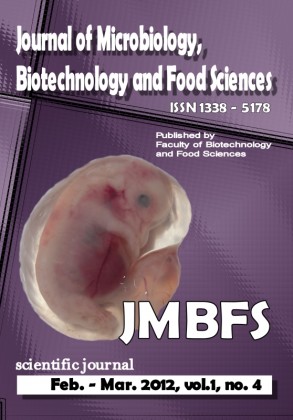EFFECT OF USING DIFFERENT LIPIDS TYPE ON SECOUNDARY AND EDIBLESCARCASSES PARTS OF BROILER (COOB-500)
Keywords:
broiler carcass, secondary and edible carcass parts, different marketing agesAbstract
This experiment was conducted in the Nawroz broiler's field in Asky-Kalak Mosul-Iraq. The effects of added dietary fat types and levels on broiler strain (Cobb500) of secondary and edibles carcasses parts were evaluated in three treatments. Treatment one (T1) supplied with 5% vegetable fat (VF) traditional fat used in most farms of Iraq (palm oil) treat by hydrogenation industry. Treatment two (T2) is mixing from 2.5% VF hydrogenation (palm oil) with 2.5% sunflower oil (SUN). Treatment three (T3) included 5% sunflower oil. Six repetitions were used from day one age to four marketing ages (42, 45, 48 and 51 days). There were significant differences (P<0.05) among all treatments at all periods marketing ages for carcass weight. The high values were in T2 (1721g, 2140g, 2487g and 2763g) at 42, 45, 48 and 51 days respectively.Insignificant differences (P>0.05) for neck weight at 42 days and 48days ages observed for wing weight, at 45 days and 51 days there were significance (P<0.05) High value found in T2 (175.5g and 248.3g) at 45 days and 51 days respectively. Back weight, liver weight, pad fat weight, total digestive system weight, intestine weight, bile salt weight and heart weight were insignificant differences at 42 days age. High values for back weight at 45day was in C (376.2g) and at 48days,51 days were in T2 (407.2g, 440.4g) respectively. Liver was just significance (P<0.05) at 48 days and high value was in T2 (58.9g). Pad fat weight were significant (P<0.05) at 45 days and 51 days and high values were (41.03g, 71.6g) for T2 and T1 respectively. Head weight just at 42 days significant (P<0.05)and higher value was in T1 (45.7g). Total digestive system values was at C group at 45 days (229.5g) and at 48, 51days were in T2( 339.1g, 286.0g) respectively. Feather and blood were significant (P<0.05) at 42, 45 days higher values were in T1 (389.9g, 575.8g) respectively, but at 48, 51 days were highest values in T2 (541.2g, 488.3g) respectively. High value for intestine was in 45days at C (147.8g), and higher value at 48, 51 days were in T2 (175.5g, 183.6g) respectively. Bile salt insignificant (P<0.05) at 48, 51 days and higher value were (3.07g 3.45g) respectively, gizzared and heart were high value in T2.Downloads
Download data is not yet available.
Downloads
Published
2012-02-01
How to Cite
Abdullah Mohammed*, H., Omer Miran, D., & Yasine A.L. y, S. (2012). EFFECT OF USING DIFFERENT LIPIDS TYPE ON SECOUNDARY AND EDIBLESCARCASSES PARTS OF BROILER (COOB-500). Journal of Microbiology, Biotechnology and Food Sciences, 1(4), 1152–1167. Retrieved from https://office2.jmbfs.org/index.php/JMBFS/article/view/7258
Issue
Section
Food Sciences
License
Copyright (c) 2012 Hasan Abdullah Mohammed*, Dara Omer Miran, Sardar Yasine A.L. y

This work is licensed under a Creative Commons Attribution 4.0 International License.
All papers published in the Journal of Microbiology, Biotechnology and Food Sciences are published under a CC-BY licence (CC-BY 4.0). Published materials can be shared (copy and redistribute the material in any medium or format) and adapted (remix, transform, and build upon the material for any purpose, even commercially) with specifying the author(s).

